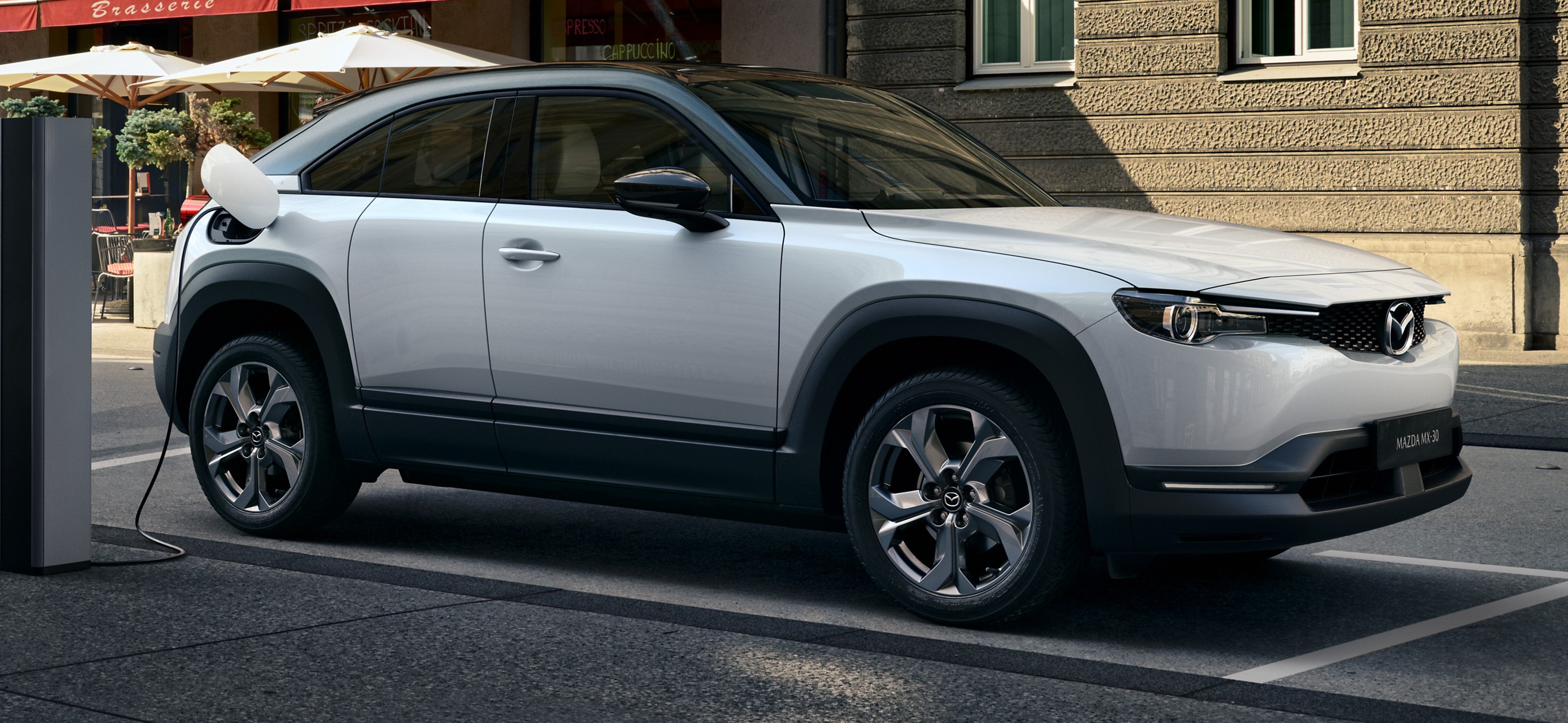
Mazda’s first full-production BEV, the Mazda MX-30 will go on sale in the UK early in 2021.
Mazda’s first production electric car, the Mazda MX-30 has been revealed at the Tokyo Motor Show and stands apart as battery electric vehicle developed for customers who don’t want to sacrifice driving pleasure when they buy an electric car. With its unique freestyle doors, ecological materials and right-sized battery giving a range of approximately 125miles[1], exceeding the 30 mile average daily drive of the European customer[2], the Mazda MX-30 marks another positive step in Mazda’s multi-solution approach to reducing emissions following the recent arrival of the innovative Skyactiv-X engine.
A car with a battery, not a battery with wheels
Commenting on the premiere of the Mazda MX-30, which will arrive in European dealerships during the second half of 2020 and the UK in 2021, Yasuhiro Aoyama President & CEO of Mazda Motor Europe said: “As with all our products, our designers and engineers had a very clear goal for our first battery-electric vehicle. It had to have stand out design, be great to drive, something that is key part of Mazda’s DNA and makes us unique when compared with competitors, and most importantly, make a positive contribution to reducing emission across the entire life cycle of the product. Alongside the electrification technologies we are introducing across our range, being a smaller manufacturer we focused all our efforts on creating an electric car that we anticipate will be a second car where the range of our vehicle will meet customers’ needs”.
Adding, “Many of the media who have driven our test vehicle have said it is one of the few electric cars they have driven with the positive characteristics of a regular car. Delivering driving pleasure is at the heart of every Mazda we design and that will be no different in our electric car.”
A focus on the driver
Like every other Mazda, the Mazda MX-30 provides a very natural and responsive driving feel by accelerating, turning and braking exactly as you intend in everyday driving situations.
In the Mazda MX-30, this is achieved through the innovative engineering approaches in the e-Skyactiv package. This includes also the battery being rigidly integrated into the vehicle body structure which enhances the overall body stiffness and provides excellent response to the driver’s input.
In addition, given the importance of sound to a drivers’ perception of torque and speed, the Mazda engineers have also created an electronic sound system inside the Mazda MX-30 , which is synchronized to motor torque in sound frequency and sound pressure. This leads to less variation in vehicle speed resulting in very stable driving which is further supported by Mazda’s unique G-Vectoring Control (GVC) has been expanded and uses the advantages of the electric motor (electric G-Vectoring Control Plus).
Distinctive Kodo design
With the Mazda MX-30, we continue the Mazda design focus of “less is more” when it comes to the exterior and interior of our cars.
The cabin has a sense of oneness, flowing from the top of A pillar to the rear end. The colour of the framed top roof makes this feeling even clearer. The freestyle doors give the Mazda MX-30 a distinctive and elegant cabin silhouette, as well as providing customers with easier access to both the front and rear seats. In the interior, we are also introducing eco-friendly materials and are replacing much real leather with a vegan alternative. There is also environmentally sourced cork featured in the floating center console which provides creative storage space.
What’s in a name?
Mazda has used the MX prefix on several products that were designed and engineered to challenge the assumptions in the automotive industry at the time. With the MX-5 we created a sporty two seater when the roadster had been dismissed by other manufacturers.
With the Mazda MX-30, we have created a completely new EV experience with the Mazda DNA of unique interior and exterior design and great driving dynamics, ensuring that our customers are still able to experience the joy of driving for which Mazda is famous.
MINDFULLY DESIGNED WITH A PURPOSE: YOUR LIFE
From the outset, the development team behind the Mazda MX-30 wanted to create a car that would become a partner to its owner. It should beg to be driven daily, and every time customers get behind the wheel, their affection for it should grow and they should feel more and more themselves. Everything about the model, from the styling that breeds a sense of familiarity to the open-feeling cabin that sets the mind free, is uncompromisingly designed around the user.
VALUES OF THE MX-30
HUMAN MODERN DESIGN CONCEPT PUSHES OUT THE BOUNDARIES OF KODO DESIGN
For the MX-30, while retaining the beautiful, handcrafted forms of Mazda design, the design team also explored an expressive direction more in touch with emerging new values and lifestyles. That process resulted in the design of the MX-30. The Human Modern concept spurred a number of unprecedented approaches. The exterior is uncompromisingly simple to emphasize its beauty as a solid mass. The styling creates a friendly expression, and the cabin design, with its framed top and freestyle doors, embodies an image of lightness. The interior aims to give occupants a sense of being “enveloped in openness,” with a floating console and unique materials designed to minimize environmental impact. The MX-30 embodies an expressive direction in car design that helps customers discover their natural selves through the process of living with the car.
A CABIN INTERIOR THAT FOCUSES THE MIND AND FEELINGS WITH FINE CRAFTSMANSHIP AND ENVIRONMENTALLY-FRIENDLY MATERIALS
The team created an open-feeling cabin interior and paid particular attention to the selecting the right materials and showing them in ways that bring out their best. Heritage Cork used in the console tray is designed to emphasize the texture and visual warmth of the material. The door trim features a fibrous material with a texture that seems to contain air, creating a material-based sense of openness within the cabin. Both of these materials are designed to be low-impact and sustainable. The door trim uses fibers made from recycled plastic bottles and the cork is harvested from the bark of trees without felling. The comfortable interior of the MX-30 is composed of such environmentally friendly materials.
A touch panel heater control is adopted for the first time in a Mazda car, making operation safe and intuitive. This 7-inch touch panel also welcomes drivers getting into the car with a graphic that changes along with the external environment, offering an interactive experience designed to bring people closer to their car. From materials through to functionality and from technology through to design, all elements work together to create a space that encourages mindfulness from the moment customers open the door, while driving, and right up until they exit the vehicle.
A DRIVING EXPERIENCE OF PURE JOY
Mazda wants people to enjoy driving in any situation, and that applies as much to EVs as to any kind of car. In order to realize a driving experience that makes you look forward to your daily commute, Mazda has relentlessly applied the human-centric philosophy in the development of new technologies such as Skyactiv-Vehicle Architecture. Now, with the MX-30, the company introduces a new electric drive technology called e–Skyactiv. To enhance the consistency of omnidirectional vehicle response to control inputs and realize seamless transitions between G forces, electric G-Vectoring Control Plus (e-GVC Plus) is also equipped. Natural feedback crafted to match human characteristics is afforded by precise torque control and sound that lets the driver know exactly what the car is doing. Combined with the smooth vehicle behavior unique to a battery EV, these factors result in the refinement of Mazda’s renowned driving joy.
ADVANCED SAFETY PERFORMANCE FOR ENJOYMENT AND PEACE OF MIND
Aiming for a future society free of car accidents, Mazda is continually working to advance safety performance under the Mazda Proactive Safety philosophy. The MX-30 strengthens the i-Activsense advanced safety technology suite with new functionality added to Smart Brake Support aimed at helping to prevent collisions at intersections and technology designed to help keep drivers on track on roads with curbs or discernable edges, even in the absence of lane markings. And thanks to a body that is both strong and efficiently absorbs energy despite adopting freestyle doors with no center pillar, collision safety performance is excellent. Mazda’s engineers incorporated the latest technologies and development concepts, including a carefully designed structure to protect the high-voltage battery, so that anybody can enjoy the responsive performance of the MX-30 with peace of mind.
A CAR THAT STIMULATES CUSTOMERS TO USE IT IN NEW AND CREATIVE WAYS
Mazda aims to create a deeper bond between people and cars and make life with a car a richer and more rewarding experience. With the MX-30, the company hopes to offer not only a new choice for customers but new and life-enriching ways of using and spending time with your car. In addition to the above-mentioned values, the adoption of the freestyle doors not only enhances functionality but opens up a wide range of new and creative uses for the MX-30. Mazda hopes that, in addition to enjoying the drive, customers will use the car creatively and make it truly their own.
HUMAN MODERN DESIGN CONCEPT EXPANDS KODO DESIGN’S EXPRESSIVE RANGE
The debut of the all-new Mazda3 marked the beginning of a new phase of Kodo—Soul of Motion design. Under the Car-as-Art ethos, Mazda designers are striving to expand Kodo’s expressive range and enhance the artistic value of car design. Styling the MX-30 was a process of staying grounded in the beautifully honed, handcrafted forms of previous Mazda designs while exploring new directions more in touch with futuristic values and lifestyles that are beginning to emerge. Based on a “Human Modern” design concept, this new approach has resulted in an original design that embodies the expansion of Kodo’s expressive range. The exterior is uncompromisingly simple to emphasize its beauty as a solid mass. The front face bears a friendly expression, and the cabin design, with its framed top and freestyle doors, embodies an image of lightness. The interior aims to give occupants a sense of being “enveloped in openness,” with a floating console and unique materials chosen to minimize environmental impact.
By living with the MX-30 from one day to the next, owners will find themselves discovering their true natural self. As we begin an era of great change, I want this to be a car shows people that cars can still offer such new value. I hope the thought that went into designing the MX-30 is evident, and that you can easily sense the personality created by this spirit.
EXTERIOR DESIGN
The MX-30’s solid mass leaves an impression of strength and beauty. It also gives the exterior its thoroughly modern flair. Concerted effort went into creating a pure look of solidity that reflects the beauty of shaving away all unnecessary elements as proposed by the latest expression of Kodo design. The strong, simple expression of its meticulously calculated form gains presence that only becomes complete when it projects the lifestyle and tastes of the customer. The natural presence of space within this simple form establishes the exterior’s Human Modern touch.
FRONT DESIGN
Particular emphasis went into designing the front to serve as the starting point for the MX-30’s image as a solid mass that leaves an impression of simplicity and strength. At the same time, it expresses a dynamic vitality that conveys trustworthiness and familiarity. To achieve this, Mazda boldly did away with the signature wing that is used on other products in its model lineup. All reflections and elements converge on the Mazda logo at the center, and this becomes the highlight feature of the expression. The aim is to go beyond the simplicity one sees at first glance and suggest an underlying nuance of reliability and intention. While breaking new ground for the expression of Kodo design, the strong form it incorporates combines with the deep sculpted form around the headlamps to realize a new front design featuring Mazda’s characteristic vitality.
SIDE DESIGN
The image of a strong, solid mass originates at the front end and travels along the sides of the body as a consistent large surface that extends to the rear end. It is an extremely simple structure. The D-pillars sweep down at a sharp angle to seamlessly blend the roof and cabin with the solid mass at the rear. To keep these simple forms from growing tedious, the A-pillars stand boldly upright to punctuate the flow with an effective “Charge and Retreat” expression. The surfaces that appear flat along the body sides are in fact formed with a bold curve in them that continues from the front end to the shoulder highlights. It is a simple, strong and nimble looking design that leaves a memorable impression when the MX-30 is viewed from the side.
LAMP DESIGN
The same cylindrical headlamp design used on all Mazda’s new-generation cars expresses a look of depth with distinct features. To highlight the three-dimensionality of the rear combination lamps, the outer lenses adopt a design that follows the shape of the lamp housings.
FRAMED TOP
Painting the side sections of the cab between the A-pillars and D-pillars, as well as the side of the rear liftgate, in a metallic color emphasizes the cabin’s streamlined look of speed and of being integrated with the rear end. The roof is blacked out in order to highlight the metallic portions. This achieves both a sense of lightness and color combinations that leave an impression of modern styling. The framed top style will be made available in combination with the Soul Red Crystal, Polymetal Gray and Ceramic Metallic body colors.

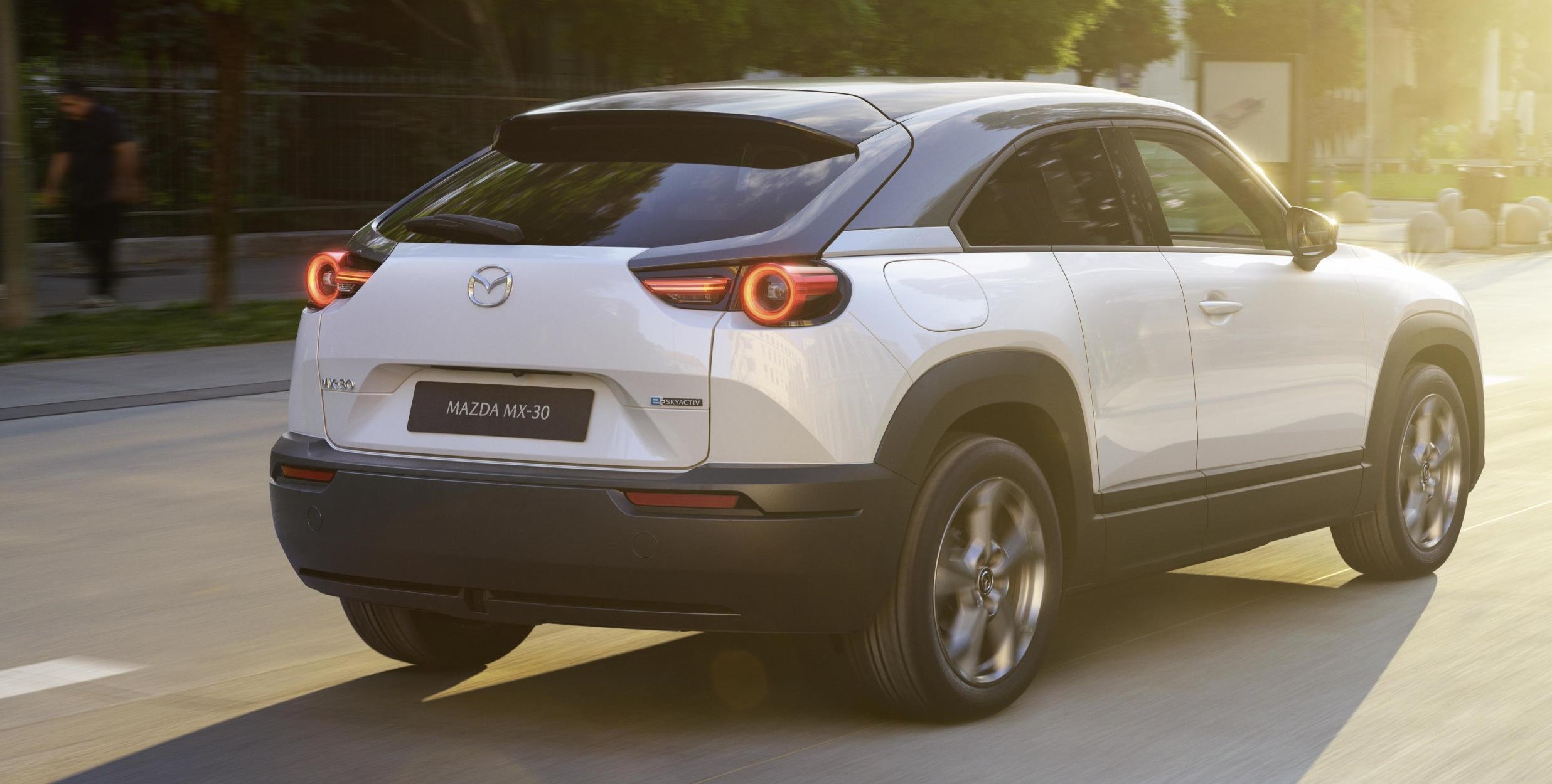
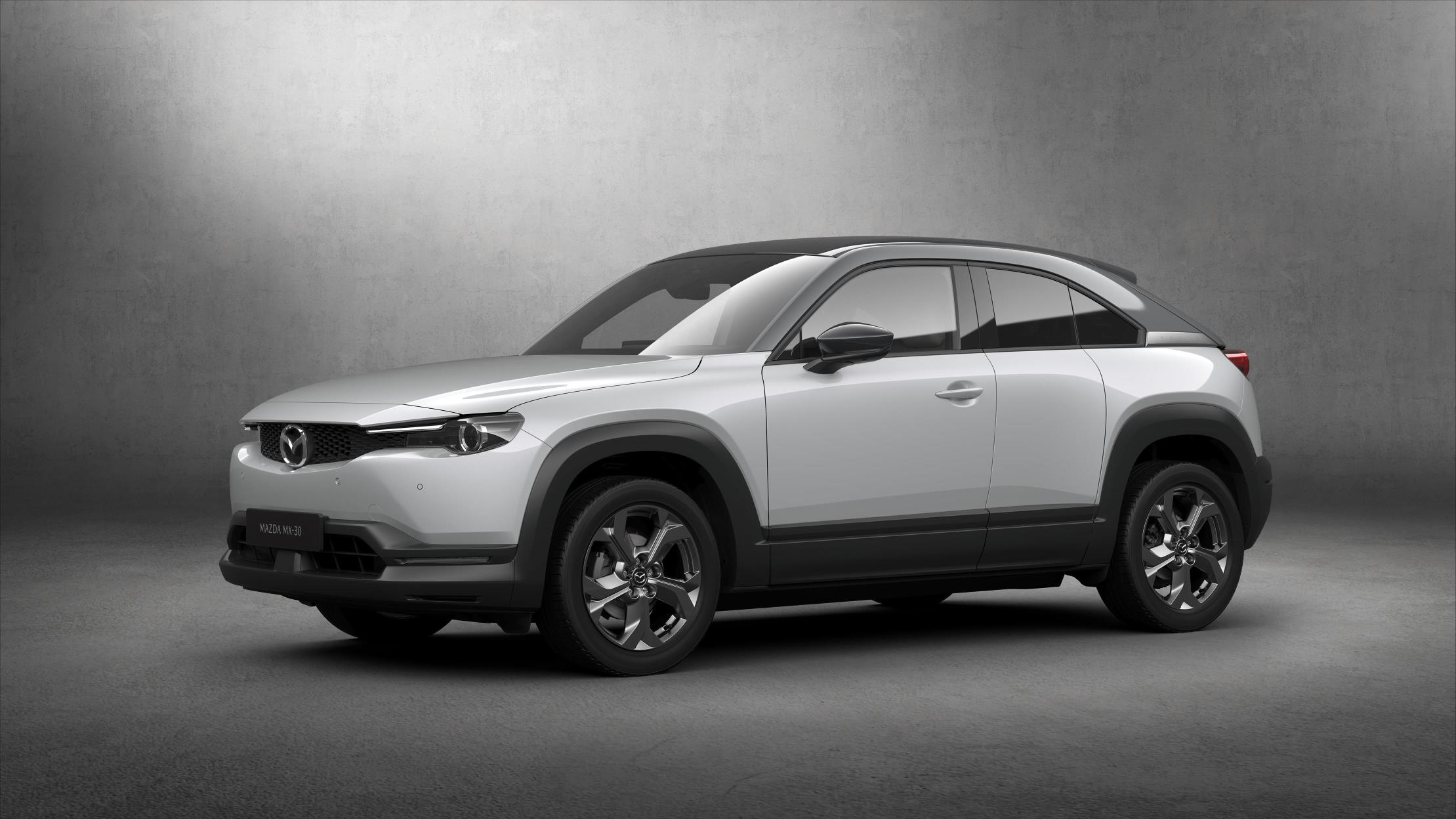
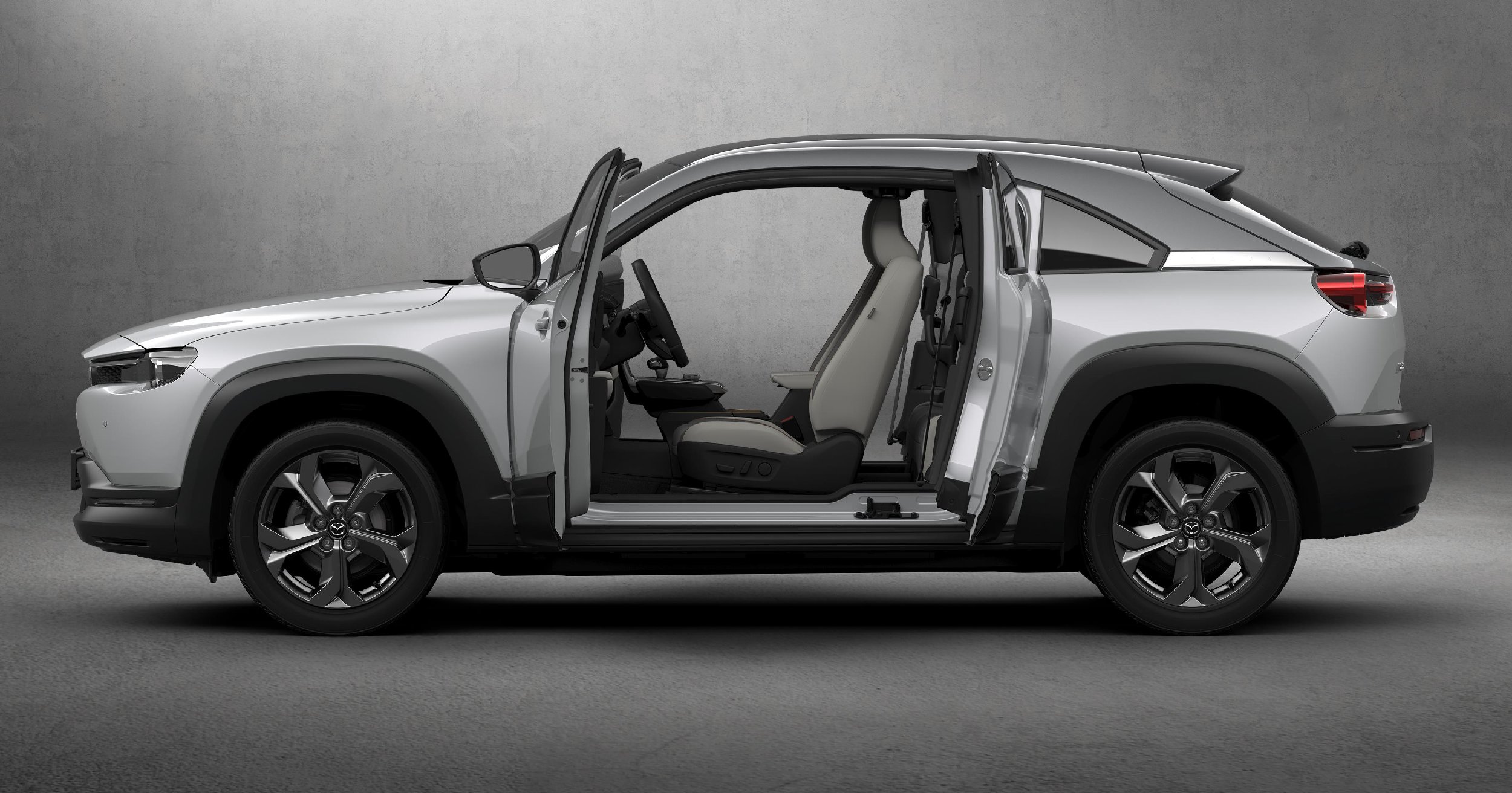
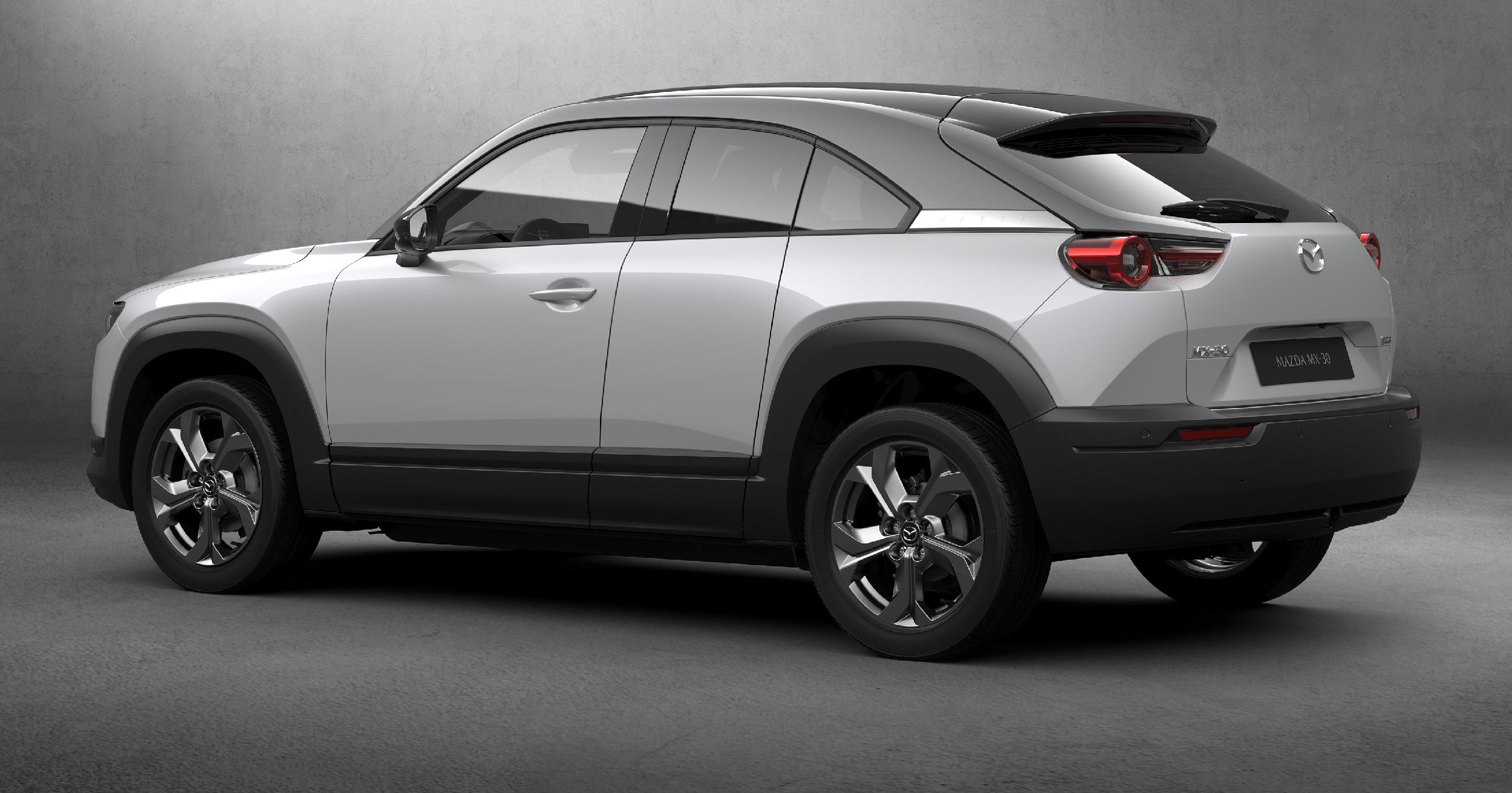


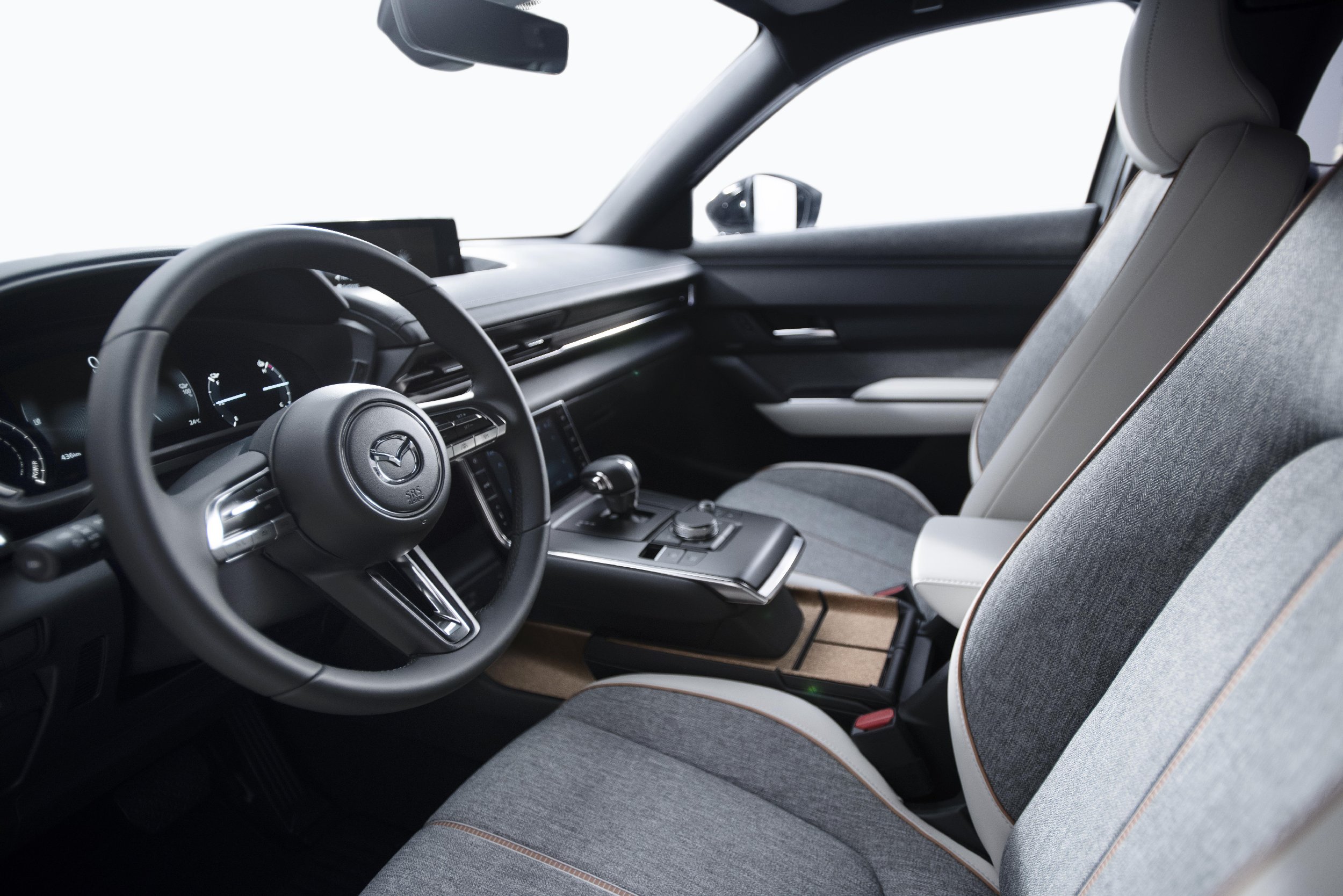

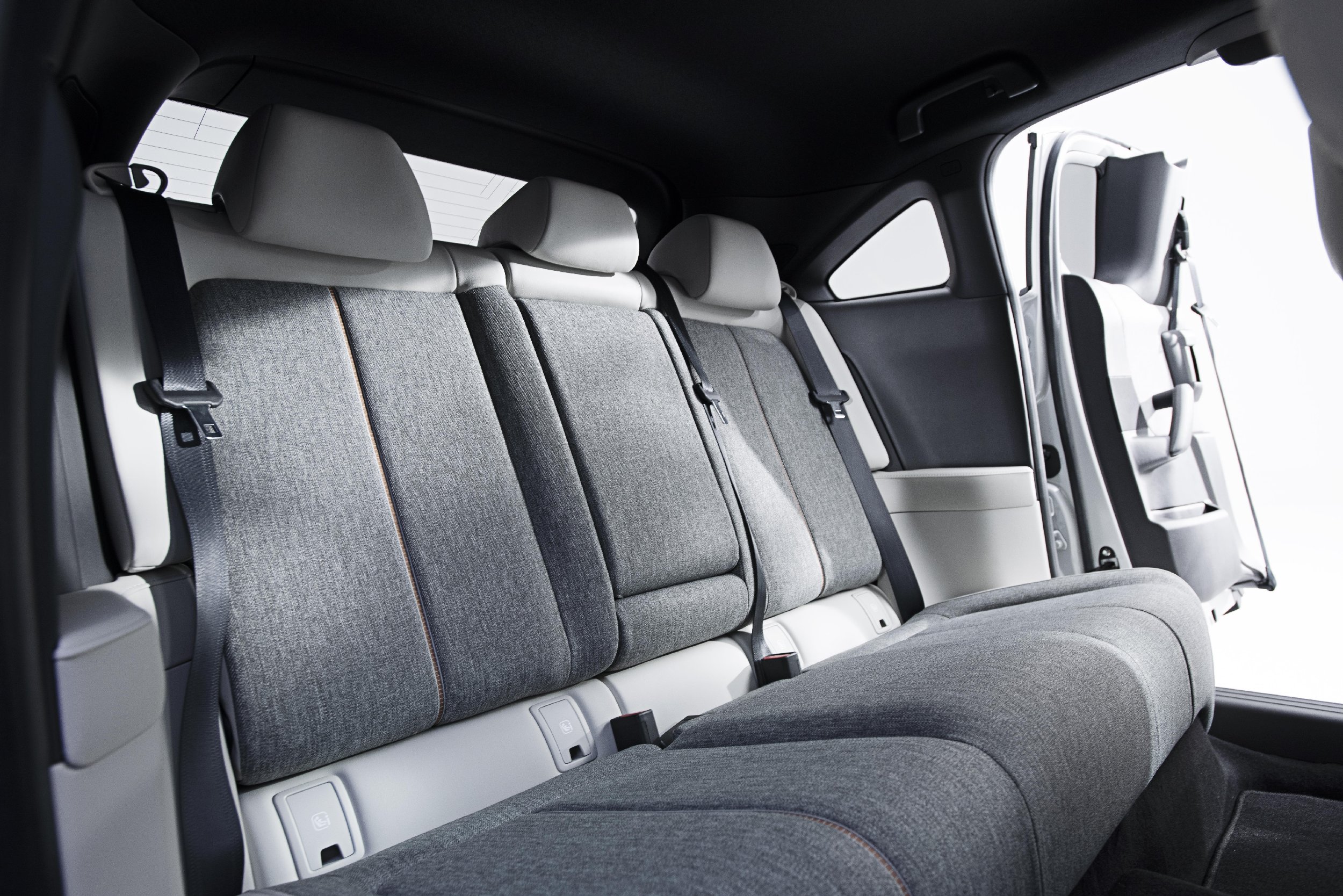
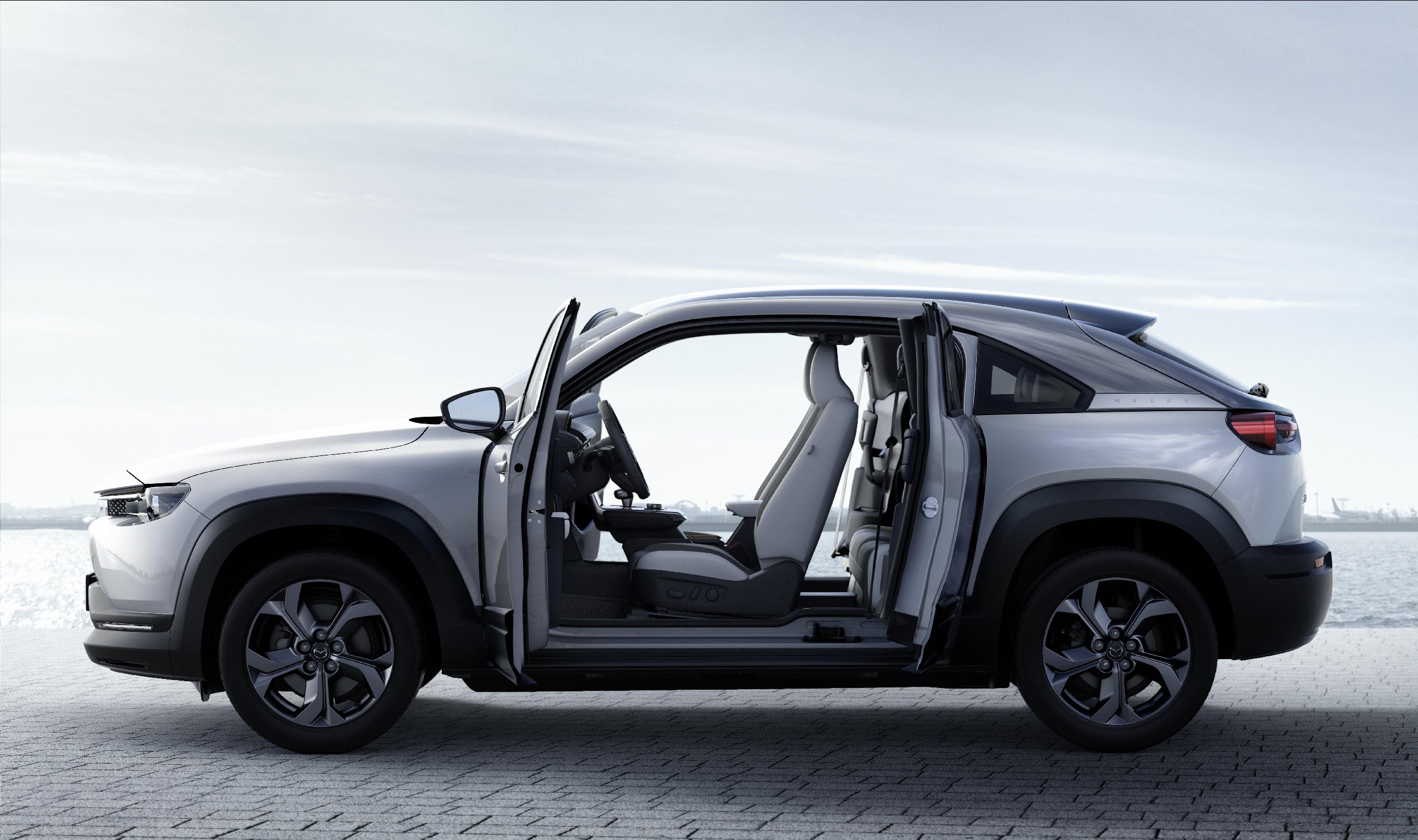

INTERIOR DESIGN
The MX-30 interior employs the latest design expressions and technologies in aiming to achieve an ambience of spaciousness and openness within the cabin. It adopts a floating style to help realize this sense of openness. Accordingly, materials that help free the spirit were carefully selected and meticulously finished. Concurrently, the adoption of Freestyle doors enables an interior form that seems to wrap around the occupants in comfortable fashion. The interior provides an environment conducive to settling one’s mind and regaining a sense of one’s self. This is the interior’s expression of the Human Modern design concept.
FRONT SEAT SPACE
Without changing Mazda’s characteristic driver-centric cockpit layout and feeling it brings of being physically at one with the car, the MX-30 furthers the philosophy of the horizontal layout to give the interior a simpler, wider look. One change implemented to create a look of greater simplicity within the cabin is the introduction of a touchscreen air-conditioning control panel. In addition, the floating floor console, upper section of the instrument panel, meter hood and related trim are designed to create a sense of continuity and lightness. While these innovations do indeed add functional value, Mazda pursued their development as part of an initiative to delve into the realm of value experienced through the senses. The design was subsequently brushed up through a collaborative effort withengineers using analytic data on human characteristics. From the moment one of its doors is opened, the cabin leaves a strong impression of liberating spaciousness. At the same time, it provides the driver as well as all passengers with an enhanced feeling of being physically at one with the car.
REAR SEAT SPACE
The MX-30 takes advantage of its Freestyle doors by using the side door trim for the rear seats to create a design that resembles a couch. The rear seat not only provides a pleasing environment that surrounds rear seat occupants in comfortable fashion, it also stimulates the owner’s creativity the instant he or she opens one of the Freestyle doors by presenting near-limitless usage possibilities.
FLOATING CONSOLE
One of the MX-30’s highlight features is the floating console that stands independent of the surrounding interior components and plays home to all necessary controls. This combines with the new touchscreen display to become one of the MX-30’s truly modern touches. The space to which this floating design gives birth can be used freely for stowing items, while also serving to create a stronger sense of connection between the driver and passenger seats.
COLORS, MATERIALS AND CRAFTSMANSHIP
Development of colors and materials for the MX-30 focused on achieving a modern expression through the adoption of a natural, high-quality look. Mazda also strove to use materials that show an even greater respect for conserving our environment. Approaching this from the perspective of extracting the natural appeal of the materials used, top priority went to finding the sweet spot between sustainability and comfort. While fit and finish receive the same fine attention as on the other models in Mazda’s new-generation lineup, they also raise the bar another notch.
HERITAGE CORK
Because no trees are cut down and only the bark is stripped away to obtain the material, cork is a naturally derived product with low environmental impact. The MX-30 uses cork left over from the production of cork bottle stoppers. The material’s inherent warmth, gentle touch and cushioning are put to good use in the console’s tray section as well as on the door grips. To ensure the high level of durability required for use as car parts, Mazda developed a dedicated coating and a special technique to process the cork and its base material at the same time. The material also pays tribute to the company’s heritage by harkening back to Mazda’s founding in 1920 as the Toyo Cork Kogyo Co., Ltd.
BREATHING FIBER (EXCLUSIVE FABRIC)
Fabric designed exclusively for its pile, density and color is adopted on the upper section of the door trim. Different from previous applications of plastics or leather, it helps to achieve the expression of openness in the cabin by providing a soft touch as though the fabric itself contains air. The fabric is made from recycled PET bottles.Development of a new method for integrated molding of textile and plastic fibers made it possible to create a material with a soft touch that can be processed easily.
MAZDA’S NEW PROPOSAL FOR SATISFYING DIVERSE NEEDS.
PACKAGING THAT STIMULATES CREATIVITY THROUGH FLEXIBILITY.
People spend a lot of time with their cars; they are a big part of our lives. This is why Mazda wants to make their car a place they can relax and be themselves and an experience that enriches their daily routine, raising expectations of good times and new possibilities. To achieve this, the interior of the MX-30 combines functionality based on the latest research into psychology and ergonomics with a design theme that creates the novel sensation of being “enveloped in openness.” At its base is Mazda’s characteristic driving environment, which builds on human-centric design to achieve the ideal driving position and implement the brand’s Human-Machine Interface (HMI). The MX-30 is focused on the emotional connection between car and person and aims to provide a space where people can relax and be themselves, including when they are not driving the car. A new experience begins the moment one opens the doors. Because the space puts the driver at ease, they can enjoy a pure Jinba-ittai driving experience on a deeper level than ever before. Likewise, when parked they can explore a variety of new ways to use a car. The MX-30 stimulates people’s creativity and offers an enriching time that allows people to connect in a variety of ways. Mazda hopes it will be a car that begins a new era and opens the door of new possibilities as wide as the freestyle doors themselves.
FREESTYLE DOORS
One of the most outstanding features of the MX-30 is its unique center-pillar-less Freestyle doors with custom-designed hinges that allow the front doors to open to 82° and rear doors to open to 80°. This not only makes entering and exiting the car and loading and unloading cargo easier but also provides easier access for strollers and wheelchairs. The wide angle to which the front doors open was designed to facilitate this wide variety of usage styles. For example, the layout and the absence of a center pillar make it possible to bring a stroller right up beside the rear seat and smoothly and comfortably put a baby into a child seat while maintaining eye contact. The front door is opened first, followed by the rear door, and both can be opened without changing position. Opening the freestyle doors wide provides a new view and, in addition to improving access, opens a range of new possibilities for enjoying the car. For instance, drivers may wish to take time out of their daily routine to stop by the park, open up the doors and listen to the sounds of nature for a few moments or to use the car like base camp from which to enjoy outdoor activities with their friends.
To further enhance the freedom of ingress and egress provided by the Freestyle doors, the height and shape of the door openings are designed in accordance with human characteristics. The rear door trim adopts a vertical grip that makes opening and closing the door easier and that does not place much burden on the wrist when reaching for it, even with the door wide open. The front seats are equipped with a walk-in mechanism that, with a single touch, folds the seatback forward and simultaneously slides the whole seat toward the front.1 The folding angle and slide distance were chosen in consideration of the occupant’s body movements, ensuring smooth entry to and exit from the rear seats. The cross-section of the side sills and shape of the side sill garnish are also carefully designed to facilitate smooth, effortless exit from the cabin.
1 Depends on specifications.
HUMAN MACHINE INTERFACE (HMI)
FLOATING CONSOLE
The shift lever and commander control are positioned toward the front and the center armrest is high so these controls can be operated with the arm at a natural angle. The center armrest also adopts a slide mechanism. The layout affords all drivers a comfortable posture, regardless of their build. Cupholders are positioned in the deeply recessed area between the shifter panel and the center armrest. The height of the armrest makes both putting drinks in the cupholders and operating the commander easy and natural. A distinctive feature of the MX-30 is the opening in the lower area at the front of the console, which can be used as a storage space. It achieves a clean design that also offers added functionality.
7-INCH TOUCHSCREEN DISPLAY
INTERACTION THAT BRINGS YOU CLOSER TO YOUR CAR
The MX-30 adopts a 7-inch touchscreen display at the front of the console that encourages closer communication between car and driver. When the driver opens the door and gets into the car, a subtly changing graphic appears on the screen. The graphic changes look depending on the time of day and the temperature outside and helps get the driver in the mood for driving. Once the car is switched on, it displays the air-conditioning controls and lets the driver know that the car is ready to go.
TOUCHSCREEN AIR-CONDITIONING CONTROLS
The 7-inch display integrates design and function at the highest level by serving as a touchscreen air-conditioning control panel when driving. Temperature, airflow and seat heater adjustments can all be controlled via the touchscreen. The controls are displayed in simple fashion and functions are grouped intelligently so all operations can be performed intuitively and quickly. Push switches mounted on the display’s bezel offer alternative control over A/C on-off, auto control, temperature adjustment, fan speed and window demisting. These switches help ensure proper operation, even when wearing gloves.
DRIVING POSITION
The MX-30 shares the same basic cockpit design found on all Mazda cars, with a horizontally symmetrical layout centered on the driver. It offers a driving position that feels natural and enables the driver to focus confidently on the road ahead.
SHIFTER
The MX-30 adopts electronic gear shifting. In keeping with Mazda’s philosophy of placing top priority on safety, the MX-30 uses the same stationary design as the company’s conventional AT shifters. That means the lever locks into each of the P-R-N-D positions, making it easier to determine what gear the vehicle is in at any given time. The shift pattern puts D (Drive) at the back, R (Reverse) at the front and P (Park) offset to the side at the front. This intuitive and simple scheme supports sure and safe operation.
VISIBILITY
The MX-30’s seating position is set relatively high to secure a clear and unobstructed view. Optimization of the way the hood appears from the driver’s seat makes it easier to recognize the position of the front nose, helping to give the driver a better sense of the vehicle and its proportions. Attention to these details improves driving ease in scenes that can otherwise make drivers nervous, such as when driving on narrow roads or in parking lots. The shape of the rear door glass and quarter windows were carefully designed in accordance with studies on human characteristics. This enables drivers to turn their heads in place and clearly see vehicles diagonally behind the MX-30, allowing him or her to change lanes or back up with greater confidence.
COMFORT
To create a sense of being “enveloped in openness,” the front seats of the MX-30 are separated by a floating console. This not only creates an open space between the left and right sides that customers can use as they wish, but it has also been carefully designed to enhance a sense of togetherness connecting driver and passenger for a more pleasing and communicative driving experience. The rear door glass and quarter windows are positioned to enable rear seat occupants to view the scenery outside from a natural seated position, while the rounded space created by the doors, side trim and rear seats is designed to convey a feeling of being wrapped in reassuring comfort.
LUGGAGE SPACE
The luggage area is large enough to accommodate four (115cm) carry-on suitcases,1 realizing the space needed for use in a wide range of situations, from leisure to everyday use. There is also a sub-trunk beneath the floor that is convenient for storing small items. The height from the ground to the lower edge of the luggage area’s opening is designed in accordance with human characteristics to make loading and unloading luggage items easier. The space presents a clean look of quality and roominess, and care was taken with details such as minimizing the height difference between the luggage area and the rear seatbacks when they are folded down to make the space as easy to use as possible.
1 Depends on their shape of the suitcases.
POWER SUPPLY FUNCTION
The MX-30 offers a rich set of power supply functions as it aims to support a variety of lifestyles. A pair of 2.5A USB ports and a 12V DC power socket are mounted on the front of the floor console as standard equipment. These power outlets make it easy to charge a smartphone, tablet or some other device. The model also includes a 150W AC outlet,1 making it possible to charge devices with larger batteries, such as notebook computers, e-mobility and drones.
1 Differs according to the destination market.
DRIVING GETS MORE ENJOYABLE WITH EVERY OUTING.
HUMAN-CENTRIC DESIGN DELIVERS A PURE DRIVING EXPERIENCE IN AN ELECTRIC VEHICLE.
Mazda has long challenged to deliver driving pleasure based on its Jinba-ittai driving experience. With the 2019 launch of the latest generation Mazda3, Mazda introduced Skyactiv-Vehicle Architecture, a set of new-generation structural technologies born of efforts to further evolve its human-centered development philosophy. As the third entry in Mazda’s new-generation car lineup, the MX-30 adopts this advanced technology, as well as its new e-Skyactiv electric-drive technology. As a result, the MX-30 realizes a pure driving experience that skillfully blends the dynamic performance and faithful response Mazda values so highly with smooth behavior and seamless operation. The MX-30 makes driving more enjoyable with every outing. The introduction of e-Skyactiv adds a new layer of depth to the driving pleasure derived from Mazda’s Jinba-ittai driving experience.
AN EV THAT AIMS TO DEEPEN THE JINBA-ITTAI EXPERIENCE
Jinba-ittai. It’s about the car and driver’s intention moving together as one, providing greater confidence, safety and faithful response. The desire to provide this Jinba-ittai driving experience led to the birth of technologies that leverage Mazda’s human-centric development philosophy to maximize the potential of human abilities. That’s how Mazda builds cars. Both the multi-directional ring structures of the body and G-vectoring control (GVC) were evolved to develop technology and fully exploit the characteristics and unique qualities of an EV. Mazda also developed its own unique motor pedal for the MX-30. These technologies realize seamless vehicle motion in all directions, composed ride quality coming from a feeling that the vehicle constantly gravitates toward the road surface, and an intuitive feeling of total control over all operations, including driving, turning and stopping, that makes such actions feel as though the car is an extension of driver’s body. The result is a further evolved expression of the Jinba-ittai driving experience.
E-SKYACTIV ELECTRIC-DRIVE TECHNOLOGY
Mazda developed new e-Skyactiv electric-drive technology to realize an EV that runs purely on electric power. By fusing a system that uses a lithium-ion battery pack and electric motor with technologies born of Mazda’s human-centric development philosophy, the MX-30 realizes a driving feel by which the car faithfully responds to the driver’s intentions.
SYSTEM CONFIGURATION
The high-voltage components that comprise the e-Skyactiv system include the motor, battery pack, inverter, and DC-DC converter. The direct current from the battery is converted to alternating current by the inverter to drive the motor, while the DC-DC converter steps down the voltage to supply power to the car’s various 12V auxiliary equipment.
The motor, inverter, DC-DC converter and junction box are integrated into a single high-voltage unit that is mounted toward the front of the car. The size of the high-voltage battery mounted beneath the floor was carefully chosen to minimize CO2 emissions throughout its life cycle, from resource extraction through to battery disposal. To limit the height of the battery pack, it uses a high-density battery module and thin busbar wiring as part of a scheme that minimizes the size of wiring between high-voltage parts, as well as a thin cooling system. As a result, it minimizes the impact on interior space and helps secure roomy comfort in the cabin. As an additional measure, the battery case is joined to the body to effectively help increase overall rigidity. The normal and rapid charging ports are packaged as a set that is accessed from the right rear fender, with the onboard AC charger positioned in the luggage area.
Another feature is a control scheme that minimizes energy loss throughout the system, including loss from the inverter, the motor and in converting battery power into drive power. This combines with harmonious control between the system and the vehicle that reduces power consumption to maximize the amount of energy that goes directly toward powering the MX-30.
BATTERY COOLING SYSTEM
The MX-30 adopts a refrigerant cooling system that cools the battery pack when the temperature rises. By maintaining the best possible battery temperature even on hot days, the system helps protect the battery pack from degrading due to heat. Thin cooling tubes attached to the bottom plane of the battery module make contact with a heat exchanger. This structure contributes to realizing a compact battery pack. A sensor constantly monitors the battery’s temperature and controls the flow of coolant as needed. The result is an effective battery cooling system. Cooperative control between the air-conditioning and battery cooling systems achieves effective cooling performance for both systems.
PROTECTIVE STRUCTURE FOR THE HIGH-VOLTAGE COMPONENTS
To prevent direct contact with the high-voltage components, the system adopts a cover and a control system that instantly shuts down power flow when it detects any irregularities. It also features a protective structure that protects the battery from external forces in the event of a collision, along with a mechanism to block off the high-voltage power. These measures prevent electric shocks in the event that an accident of some sort damages the high-voltage components.
CHARGING METHODS
The e-Skyactiv system can be charged using AC power or rapid-charged using DC power. The model supports DC charging with either the CHAdeMO or COMBO standard. Adopting the most appropriate standard for a specific region makes it possible to charge the MX-30 at any charging station in the world. AC charging of up to 6.6kW is also supported.
NEW-GENERATION STRUCTURAL TECHNOLOGIES: SKYACTIV-VEHICLE ARCHITECTURE
Human beings have an amazing unconscious ability to control their legs, pelvis and spine in a way that balances their bodies and suppresses head sway when walking or running. To make it possible for people to tap into this natural ability in the car as well, Mazda worked to develop a human-centered design where the seats, body and chassis work together as an organic whole. This led to the birth of the new-generation structural technologies that comprise Skyactiv-Vehicle Architecture. The goal was to allow people a natural seating position that can be comfortably maintained while driving. Unflinching determination to pursue this goal led to creating a perfect fit with human sensibilities in terms of ride comfort and handling stability.
Toward this purpose, the MX-30 takes Mazda’s original body concept, which is based on straight framework bolstered by continuous ring structures, and enhances it by increasing its rigidity and energy transmission efficiency. The vertical, lateral and longitudinal connections of the body’s multi-directional ring structures increase rigidity while reducing lag in energy transmission and maximizing the function of the dampers and tires. By concentrating energy input from the road surface in specific locations and using the damping structure that serves as a buffer material to absorb it, the body effectively reduces vibration that would otherwise cause noise and does so without increasing vehicle weight. Incorporating the battery pack as a part of the body’s ring structure enhances the multi-directional ring structures of its basic design by greatly increasing diagonal rigidity. Specifically, the frame that surrounds the battery pack is connected to the body in 20 locations. Straight crossmembers sandwiching the battery pack from above and below combine with a reinforced ring structure for the rear axle mounts significantly reduces the delay in the transmission of inputs. Careful control over the rigidity of the battery pack mounts lets the MX-30 use the battery to help suppress road noise.
SKYACTIV-VEHICLE DYNAMICS NEW-GENERATION CONTROL TECHNOLOGIES
ELECTRIC G-VECTORING CONTROL PLUS (E-GVC PLUS)
In the MX-30, Mazda’s G-Vectoring Control (GVC), which uses the powertrain to improve chassis performance, has evolved into e-GVC Plus, which leverages the torque characteristics of the electric motor to optimize the front-rear load shift under an even wider range of usage scenarios. In every speed range, the system achieves smooth and seamless transitions between longitudinal and latitudinal G-forces, whether the driver is making steering corrections on a straight roads or cornering. This provides vehicular behavior that always feels natural and pleasing.
e-GVC Plus provides fine control over motor torque in response to the driver’s steering wheel operations. When the driver turns the steering wheel to enter a corner, the system reduces torque slightly to instigate load transfer to the front and assume a smooth turning posture. When the driver starts to return the steering wheel to its original (neutral) position as the car begins to exit the corner, torque is increased slightly to shift the load to the rear and stabilize vehicle behavior. This also helps assist in quickly returning to straight-line travel. If the driver quickly returns the steering wheel to the neutral position, brake moment control that settles cornering behavior operates in cooperation. As a result, it greatly improves stability when driving on mountain roads, highways and slippery surfaces. These measures realize an EV that features incomparable handling performance.
MOTOR PEDAL
The motor pedal for e-Skyactiv uses Mazda’s own electric motor torque control system to realize the desired vehicle speed and posture control based on the driver’s intended amount of acceleration or deceleration. It seamlessly connects forward and reverse torque and supports smooth fore-aft G-force control. Closely monitoring the stroke as well as the speed of the driver’s pedal action enables the pedal to meet the expectations of the driver in responding with linear application of G force. Gradual torque transition makes it easy to maintain vehicle speed when the driver operates the pedal slowly. In contrast, it interprets quick pedal operation as an indication that the driver wishes to accelerate and responds quickly by providing powerful acceleration. Following a similar scheme when lifting the foot from the pedal, the system monitors the speed with which the driver operates the pedal and controls the response of deceleration G force accordingly. Power unit mounts and other measures to increase the rigidity of the torque transmission system realize smooth and stable vehicle behavior, even as the motor torque changes from generating drive power to generating braking force. In addition, cooperative control over deceleration by the motor and brakes as the brake pedal is operated allows kinetic energy to be recovered and electricity regenerated without waste. Seamlessly connecting deceleration force as the driver moves his or her foot from the motor pedal and starts to press the brake pedal provides greater control over the front-rear load shift when stopping, maintaining a safe distance between the MX-30 and other vehicles, or when cornering.
Even though an EV produces no engine sound, Mazda’s e-Skyactiv provides aural feedback to the driver that enables him or her to subconsciously recognize the torque status of the power unit and thus control vehicle speed with greater precision. For example, when people hear the sound of a river flowing, they can imagine the amount of water and speed at which it is flowing based solely on the sound frequency and sound pressure. Mazda takes advantage of this human characteristic by actively controlling the sound through the audio system in a way that sounds natural and pleasing to the driver’s ears. Synchronizing the sound to perfectly match the motor torque makes it possible to supply the driver with feedback that precisely reflects the driving conditions and helps realize the control needed to satisfy the driver’s intentions.
BRAKING PERFORMANCE
Mazda’s ideal for braking performance is to have braking force build gently starting the instant the driver touches the brake pedal and then maintain a consistent strength level. Braking force should also drop off smoothly when gently lifting one’s foot from the pedal. Developed according to this same philosophy, the MX-30’s braking system reduces rolling resistance while increasing control. The resulting vehicle behavior enables cabin occupants to maximize their innate ability to maintain balance and enjoy a comfortable driving experience.
SAFETY PERFORMANCE DESIGNED FOR GREATER REASSURANCE AND TO HELP REALIZE AN ACCIDENT-FREE AUTOMOTIVE SOCIETY
Mazda Proactive Safety is the philosophy that guides all of Mazda’s safety performance research and development. With safety fundamentals such as driving position at its core, this philosophy drives ongoing efforts to continue evolving Mazda’s advanced i-Activsense active safety technologies and passive safety features. It of course applies equally and fully to the MX-30.
The MX-30 further evolves i-Activsense. One such evolution to the injury- and damage-mitigating brake system adds Turn-Across Traffic functionality to the existing Smart Brake Support (SBS) system to help prevent collisions when turning across traffic at intersections. The MX-30 also introduces new technologies, including Road Keep Assist, which helps keep the car on the right track even in the absence of lane markings and Emergency Lane Keeping with Blind Spot Assist, which helps prevent collisions when changing lanes. Adding these to the various safety technologies Mazda has developed and implemented to date expands coverage to apply to a wider range of driving scenes. On the passive safety front, despite the MX-30 adopting Mazda’s center-pillar-less Freestyle door system, rigid body and structures that efficiently absorb crash energy achieve a high level of collision safety performance.
ACTIVE SAFETY: I-ACTIVSENSE
SMART BRAKE SUPPORT (SBS) WITH TURN-ACROSS TRAFFIC
SBS adds a new Turn-Across Traffic function to the vehicle, pedestrian, nighttime pedestrian and bicycle monitoring functions already built into the system. When turning left at an intersection, (on left-hand drive units), the forward-sensing camera and milliwave radar sensors monitor oncoming traffic. When the system determines there to be a chance of a collision occurring, it automatically applies the brakes to help prevent impact or mitigate damage that may occur. The function only operates at low speeds and is programmed to monitor nearby vehicles.
EMERGENCY LANE KEEPING
ROAD KEEP ASSIST
When travelling at speeds of approximately 60km/h or greater, the forward-sensing camera monitors grass, curbs and such along the edges of unmarked roads. When the system determines there to be a chance of the vehicle drifting off the road, it assists steering operations to prevent that from happening. This helps instill greater peace of mind when driving on roads without lane markings.
BLIND SPOT ASSIST
The system uses 24GHz milliwave radar sensors to monitor the areas behind and to the sides of the car when travelling at speeds of 60km/h or greater. If the driver steers to change lanes when there is a threat of colliding with a vehicle approaching from the rear, the system assists steering operations to help prevent impact or mitigate damage that may occur.
PASSIVE SAFETY
LIGHTWEIGHT, HIGH-RIGIDITY BODY DESIGNED FOR SAFETY
To protect cabin occupants in the event a collision occurs, the MX-30’s center-pillar-less design incorporates a process by which hot-stamped material is first attached to the multifaceted reinforcing material before both are formed together into the A-pillar and roof side shapes. Extensive use of 1,310 MPa-class and other ultra-high-tensile steel combines with efficient energy-absorbing structures throughout. In addition, aiming to combine high-level collision safety with the Freestyle door system, hot-stamped vertical reinforcements are positioned inside the rear doors. The result is a structure that firmly receives impact energy from side collisions and effectively diffuses it out toward the body opening. Reinforcing of the front and rear hinges, as well as the side sills, has realized body strength and energy-absorbing efficiency on par with cars that have center pillars.
The MX-30 also adopts a safety system that shuts down the flow of power the instant a collision is detected. In addition, the battery packs are covered with high-strength material and surrounded by a rigid frame. This design offers the batteries solid protection, which in turn protects cabin occupants from potential secondary injuries caused by exposure to high-voltage power.
Product specification*
The Mazda MX-30 is available now for pre-order in several EU markets and will arrive in markets during the second half of 2020.
| Body type | SUV | |
| Seating capacity | 5 persons | |
| Overall length × overall width × overall height | 4,395mm × 1,795mm × 1,570mm | |
| Wheelbase | 2,655mm | |
| Powertrain | e-SKYACTIV | |
| Front suspension | MacPherson strut | |
| Rear suspension | Torsion-beam | |
| Steering | Rack and pinion | |
| Brakes (front/rear/control) | Ventilated discs/Solid discs /Regenerative cooperating brakes |
|
| Tire size | 215/55R18 | |
| Drive battery | Type | Lithium-ion battery |
| Cell | Prismatic | |
| Total voltage | 355V | |
| Total electric power (battery capacity) | 35.5kWh | |
| Motor | Type | AC synchronous motor |
| Cooling system | Water-cooled | |
| Charging | DC charging | COMBO spec |
| AC charging | Maximum input 6.6kW | |

*The stated figures are provisional values
Ref: 191023FINAL
[1] European WLTP mode
[2] For this survey Ipsos MORI conducted a representative online quota sample of 12072 adults across selected European markets in March 2019 (UK, Austria, Belgium, France, Germany, Italy, Netherlands, Norway, Poland, Spain, Sweden and Switzerland) of driving age, on behalf of Mazda.
